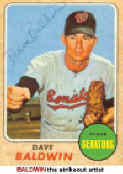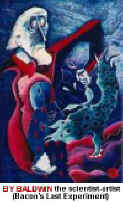
 Fields
of Dreams
Fields
of Dreams
One jack-of-all-trades is a master of many,
finds
Steve Mirsky
Dave Baldwin might qualify as a
Renaissance man, if only they had played baseball during the Renaissance.
Scientific American learned of the diamond exploits of the multifaceted Baldwin
when he wrote to us after our exposé of curveball aerodynamics. His letter,
published in January 1998, describes how as a relief pitcher for the '69
Washington Senators, he unintentionally showed up his new manager. Pity poor
Dave, as that manager was the legendary Ted Williams: Red Sox slugger, Marine
captain and general misanthrope. According to Baldwin, Williams held fast to the
conviction that pitchers (even his own) were “dumber than spaghetti" .and
challenged his staff to explain how a curve-ball did its twisty thing. The
withering silence that greeted Baldwin’s lucid curve commentary convinced Dave
that pasta might indeed be his intellectual superior.
Other events, however, strongly indicate
that Baldwin's brain works fine. He is surely the only person to publish in the Proceedings
of the Entomological Society of Washington and to pitch for that town's
team. For you younger fans, or you people who pay baseball no attention because
you find it slightly less compelling than watching paint dry, Dave's Washington
Senators are now the Texas Rangers, as opposed to an earlier team called the
Washington Senators, now the Minnesota Twins.
Such genealogical complexity doesn't faze
the former right-handed sidewinder, who went from base paths to base pairs and
earned a doctorate in genetics. He also likes watching paint dry - Baldwin made
it to Cooperstown when the Baseball Hall of Fame acquired one of his original
works of art.
 I bumped into Baldwin at the recent annual
conference of the American Association for the Advancement of Science (AAAS),
where he spoke during a session devoted to the science of baseball. Fellow
speaker Stephen Jay Gould characterized this enterprise as "basically a guy
thing rationalized as scientific and intellectual." The meeting happened to
be in D.C., already lousy with ex-Senators.
I bumped into Baldwin at the recent annual
conference of the American Association for the Advancement of Science (AAAS),
where he spoke during a session devoted to the science of baseball. Fellow
speaker Stephen Jay Gould characterized this enterprise as "basically a guy
thing rationalized as scientific and intellectual." The meeting happened to
be in D.C., already lousy with ex-Senators.
The overlap between the set
"major-league baseball players" and the set “holders of
science-related doctorates" is as measly as a team payroll back in
Baldwin's day (his maximum major-league salary was $14,000). A lone major
leaguer other than Baldwin may have gone from the dugout bench to the laboratory
bench: rumor has it that Lou Skizas, nicknamed "The Nervous Greek"
during a few years of bouncing around the American League in the late 1950s,
became a Ph.D. biologist. My attempts to contact Skizas for confirmation were
unsuccessful and may have only added to his anxiety.
 For
every thing there is a season, but Baldwin's seasons overlapped, prolonging his
Ph.D. pursuit. When he needed to be out shagging flies -Drosophila
pseudoobscura, to be exact, for studies of genetic factors determining sex
ratios -- he was busy playing ball. He wrapped up his doctorate post-pitching,
in 1979, to go with two previous undergraduate degrees and went on to pick up a
master's in systems engineering. That last field of academe is closer to the
research he presented at the AAAS: "The Decision Modeling Processes of
Baseball Managers." Responses from 44 current and former big-league
skippers to a questionnaire he designed led Baldwin to the conclusion that
"by the book" baseball strategy has disappeared. A manager may still
make an apparently traditional move, for example, bunting a runner into scoring
position, but his decision is now based on mountains of data, rather than an
adherence to established baseball tactics.
For
every thing there is a season, but Baldwin's seasons overlapped, prolonging his
Ph.D. pursuit. When he needed to be out shagging flies -Drosophila
pseudoobscura, to be exact, for studies of genetic factors determining sex
ratios -- he was busy playing ball. He wrapped up his doctorate post-pitching,
in 1979, to go with two previous undergraduate degrees and went on to pick up a
master's in systems engineering. That last field of academe is closer to the
research he presented at the AAAS: "The Decision Modeling Processes of
Baseball Managers." Responses from 44 current and former big-league
skippers to a questionnaire he designed led Baldwin to the conclusion that
"by the book" baseball strategy has disappeared. A manager may still
make an apparently traditional move, for example, bunting a runner into scoring
position, but his decision is now based on mountains of data, rather than an
adherence to established baseball tactics.
"I think what they're doing, although
they wouldn't admit this," he says, "is blame-management." That
is, if a ploy fails, the manager can point to computer printouts rather than
himself. The Ted Williams incident may come to mind again when he adds,
"You have to understand that when you're talking to managers, there is a
lot of room for misunderstanding."
His
1983 master's gave Baldwin almost as many degrees, all from the University of
Arizona, as he had wins (6). He went on to perform research at his alma mater's
college of agriculture, worked as an engineer and then did some molecular
genetics for a small pharmaceutical company. When that temporary position ended,
Baldwin devoted six years to painting, thanks to his wife's blessing and decent
income. Now 62, Baldwin earns his living consulting on data-mining techniques.
"I figure if I try enough things, sooner or later I'll find something I can
do well," he japes. Would that all our roads curved so scenically.
Copyright © 2000 Scientific American

Go to Top